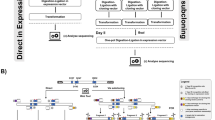Abstract
Oligonucleotide primer-directed mutagenesis is a useful molecular biological tool, which is invalubable for the study of the structure/function relationships in proteins and for the creation of mutant proteins possessing modified or novel biological activities. Mutagenesis studies in which a site-saturation approach is employed require a high-efficiency mutagenesis procedure, which will generate a population of mutated molecules containing an even distribution of all possible amino acid changes, or a subset thereof. This article describes such a mutagenesis technique and discusses the adaptations that are necessary to perform sitesaturation mutagenesis.
Similar content being viewed by others
References
Hutchison, C. A., Phillips, S., Edgell, M., Gillam, S., Jahnke, P., and Smith, M. (1978) Mutagenesis at a specific position in a DNA sequence.J. Biol. Chem. 253(18), 6551–6560.
Kunkel, T. A. (1985) Rapid and efficient site-specific mutagenesis without phenotypic selection.Proc. Natl. Acad. Sci. USA 82, 488–492.
Deng, W. P. and Nickoloff, J. A. (1992) Site-directed mutagenesis of virtually any plasmid by eliminating a unique site.Anal. Biochem. 200, 81–88.
Taylor, J. W., Ott, J., and Eckstein, F. (1985) The rapid generation of oligonucleotide-directed mutations at high frequency using phosporothioate-modified DNA.Nucl. Acids Res. 13, 8765–8785.
Sayers, J. R. and Eckstein, F. (1989) Site-directed mutagenesis, based on the phosphorothioate approach. InProtein Function: A Practical Approach (Creighton, T. E., ed.), IRL, Oxford, UK, 279–295.
Worrall, A. F. (1994) Site-directed mutagenesis by the cassette method. InMethods in Molecular Biology, vol. 30 (Kneale G. G., ed.), Humana, Totowa, NJ, 199–210.
Kegler-Ebo, D. M., Docktor, C. M., and DiMaio, D. (1994) Codon cassette mutagenesis: a general method to insert or replace individual codons by using universal mutagenic cassettes.Nucl. Acids Res. 22(9), 1593–1599.
Barettino, D., Feigenbutz, M., Valcarcel, R., and Stunnenberg, H. G. (1994) Improved method for PCR-mediated site-directed mutagenesis.Nucl. Acids Res. 22(3), 541, 542.
Mikaelian, I. and Sergeant, A. (1992) A general and fast method to generate multiple site-directed mutations.Nucl. Acids Res. 20(2), 376.
Picard, V., Ersdal-Badju, E., Lu, A., and Clark Bock, S. (1994) A rapid and efficient one-tube PCR-based mutagenesis technique usingPfu DNA polymerase.Nucl. Acids Res. 22(13), 2587–2591.
Goff, S. A., Short-Russell, S. R., and Dice, J. F. (1987) Efficient saturation mutagenesis of a pentapeptide coding sequence using mixed oligonucleotides.DNA 6(4), 381–388.
Alber, T., Bell, J. A., Dao-Pin, S., Nicholson, H., Wozniak, J. A., Cook, S., and Matthews, B. W. (1988) Replacements of Pro86 in phage T4 Iysosyme extend an α-helix but do not alter protein stability.Science 239, 631–635.
Zabin, H. B. and Terwilliger, T. C. (1991) Isolation and characterization of temperature-sensitive mutants of the bacteriophage fl gene V protein.J. Mol. Biol 279, 257–275.
O'Donohue, M. J., Scarlett, G. P., and Kneale, G. G. (1993) Tyr 26 and Phe 73 are essential for full biological activity of the Fd gene V protein.FEMS Microbiol. Letts. 109, 219–224.
Sambrook, J., Fritsch, E. F., and Maniatis, T. (1989)Molecular Cloning—A Laboratory Manual, Cold Spring Harbor Laboratory Press, Cold Spring Harbor, New York.
Hanahan, D., Jessee, J., and Bloom, F. R. (1991) Plasmid transformation ofEscherichia coli and other bacteria.Methods in Enzymology 104, 63–113.
Taylor, J. W., Schmidt, W., Costick, R., Okrusek, A., and Eckstein, F. (1985) The use of phosphorothioate-modified DNA in restriction enzyme reactions to prepare nicked DNA.Nucl. Acids Res. 13, 8749–8764.
Nakayame, K. L. and Eckstein, F. (1986) Inhibition of restriction endonucleaseNci I cleavage by phosphorothioate groups and its application to oligonucleotide-directed mutagenesis.Nucl. Acids Res. 14, 9679–9698.
Sayers, J. R., Schmidt, W., and Eckstein, F. (1988) 5′-3′ Exonucleases in phosphorothioate-based oligonucleotide-directed mutagenesis.Nucl. Acids Res. 16, 9027–9039.
Jung, R., Scott, M. P., Oliviera, L. O., and Nielsen, N. C. (1992) A simple and efficient method for the oligodeoxyribonucleotide-directed mutagenesis of double-stranded plasmid DNA.Gene 121, 17–24.
Piechocki, M. P. and Hines, R. N. (1994) Oligonucleotide design and optimized protocol for site-directed mutagenesis.Biotechniques 16(4), 702–707.
Hermes, J. D., Parekh, S. M., Blacklow, S. C., Koster, H., and Knowles, J. R. (1989) A reliable method for random mutagenesis: the generation of mutant libraries using spiked oligodeoxyribonucleotide primers.Gene 84, 143–151.
Author information
Authors and Affiliations
Rights and permissions
About this article
Cite this article
O’Donohue, M.J., Geoff Kneale, G. A method for introducing site-specific mutations using oligonucleotide primers and its application to site-saturation mutagenesis. Mol Biotechnol 6, 179–189 (1996). https://doi.org/10.1007/BF02740772
Issue Date:
DOI: https://doi.org/10.1007/BF02740772



